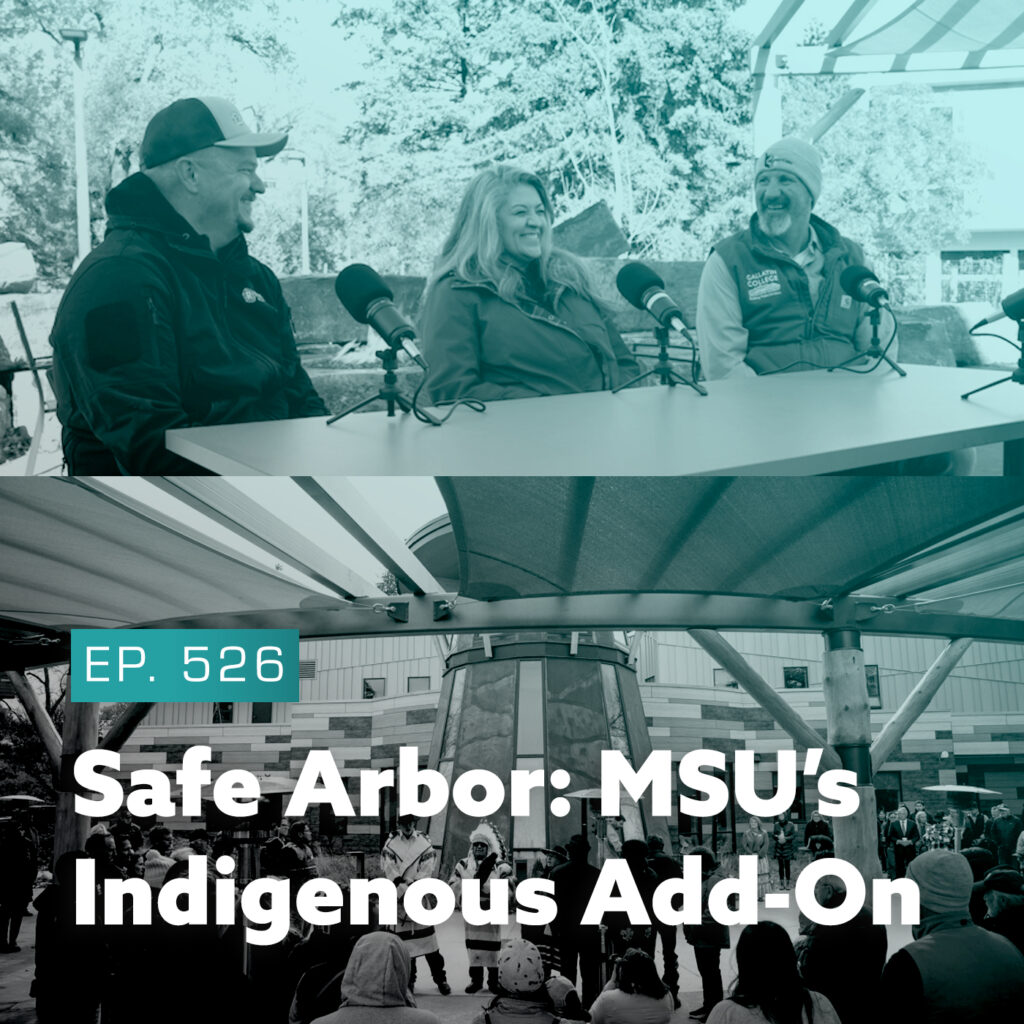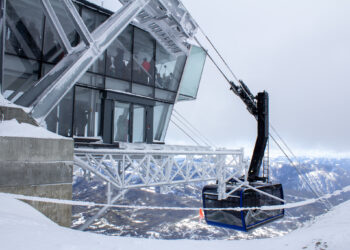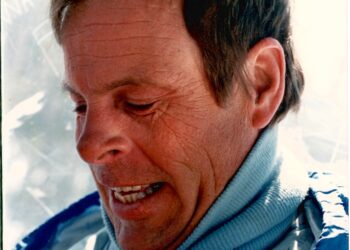The Leffingwells have passed their family’s Bracket Creek ranching tradition down five generations.
By Emily Stifler
Mike Leffingwell opens the heavy wooden sliding door and walks into the shadows of the horse barn. “This is like my second home,” he says. “I usually keep about 35 head of good, broke saddle horses.” Today, the small barn is quiet—it’s November, and all the horses are out to winter pasture. “We raise some foals, and we’ve got yearlings, two year olds and three year olds, so we run about 55 head of horses.” The old wood walls muffle his voice. Bits of hay are scattered between open stalls.
Lengths of dusty tack hang from the rafters. “My great grandfather Leffingwell was a harness maker. That’s all old harness he built.” Mike walks over to another harness hanging from hooks on the ground floor. “If I’m feeding [cattle] in the winter time with a team of horses, I still use this set, which he built as well.”
Mike walks through an open doorway into a side room, stops, props his hand on a saddle horn, and looks around. He pushes back the ball cap he’s wearing over his thinning red hair. The room, which smells like leather, saddle soap and dust, is lined on four walls with more than 30 saddles. “I can find a saddle for just about anybody,” he says. Mike, 42, is a fourth generation rancher. His family has been running a livestock operation on Brackett Creek for more than 100 years. In 1934, his grandparents, George and Mary Leffingwell, started a guest and dude ranch the family continues today.
He walks outside, through his horseshoeing shed, and out onto the dirt road. “When I’m working cattle, weaning calves or colts, or if we have to put something through the squeeze chute, we use these pens next to the barn.”
To the south, Mike’s parents George and Patricia’s house is barely visible, a quarter mile up Miles Creek. Beyond that, aspen groves are bare of leaves, and snow speckles the higher elevations of the Bangtail Divide. North of the barn, across Brackett Creek and past a grove of cottonwoods, are generations of log buildings dating back to 1941. Among them is the G-M guest lodge, as well the house where Mike lives with his wife Maria and his daughter, Mary. The hills across the road to the north are brown from the dry Indian summer. 30 minutes on horseback into those hills from the barn is Section 5, a hilltop with views of the Castle Mountains and the Crazies, the Bridger Range, the Absaroka-Beartooth and the Gallatins.
Montana’s economy has been tied to cattle ranching for 150 years. With the growing mining industry in the 1860s, demand for beef increased. In 1866, Nelson Story and a group of cowboys drove 3,000 Texas longhorns from Texas to Montana. Story started a cattle ranch in the Gallatin Valley; as the state’s largest cattle and horse breeder, his nickname was the “cattle king.” During the 1870s, the last of the Plains Indians were corralled into reservations, and the American Bison population was nearly eliminated. Huge regions of the West were left unoccupied, and the great cattle drives from Texas moved over 10 million cattle and one million range horses through this open range land. By 1895, barbed wire, railroads and settlement ended the large-scale drives, but in the next 15 years, small ranches established themselves across Montana’s range country.
In spring of 1898, Mike Leffingwell’s great grandfather, Charles Bridgman, left Zainesville, Ohio and rode the train as far west as he could go on $100. He landed in Big Timber, Montana and took a sheep-herding job up the Boulder River valley. After four years, he set off to find his own homestead. By this time though, professional homesteaders had already claimed and proved up on most of the country. Bridgman bought an established homestead on Brackett Creek, built a cabin, started a sheep farm and married the local schoolteacher, Dorothy Crichton.
In its best day, Charley Bridgman’s operation ran 6,000 head of sheep, which he summered in the Bangtails and at the base of the Bridger Mountains. Once, during the depression, he shipped three carloads of steers to sell in Chicago, expecting to make a profit. Instead, he got a bill for the freight.
Then in 1939, to boost passenger train business, the railroad company encouraged ranches to add guest lodging. The Bridgman’s daughter Mary had recently married a “fun-loving, good looking cowboy” named George Leffingwell. Together, they opened the guest business and called it the G-M, after their own first names. The business thrived.
The Leffingwells had two sons, Georgie and Hank. In Mary’s book, Trails I Have Chosen, she remembers leaving the boys with a list of chores while she and George went to town. The boys dispatched the chores and moved onto mischief:
George kept cases of dynamite in the old root cellar that he used to make ditches, move boulders, and other such jobs, as we didn’t have machinery like we do now…When we returned from Livingston, George noticed a cloud of dust hanging over the wood house and called to the boys for an explanation… They had secretly been working on [a trap door and a] tunnel for weeks in their spare time. When the neighbor boys showed up, our boys decided to hurry the digging with the help of a little dynamite… When the dynamite exploded, the blast lifted the wood shed about four feet in the air, disintegrating the rotten bottom logs…They were all pretty shook up, scared, and willing to confess by the time we got home.
Years later, George Jr. met his future wife, Patricia, when she was visiting the guest lodge with her father.
Before Mike, George and Patricia’s son, took over running the ranch, he “cowboyed and buckarooed around” the country for a few years. When he returned to Brackett Creek, he met Maria. Originally from Honduras, she’d come to the ranch to clean houses. “I was a mail order bride for somebody else,” she says. “It’s a long story.” Mike and Maria fell in love and married, and he took a job managing a neighboring ranch a mile down the road—his family’s original homestead. After living
20 years in Brackett Creek, Maria loves everything about ranching, particularly cooking, which she learned from Mary Leffingwell, Mike’s grandmother.
The G-M runs mostly Angus cattle, which are well adapted to the environment and seasons in Montana. In summer, the Leffingwells graze their cattle on the 60,000 acres of Forest Service land on the Bangtail Mountains south of the ranch. Mike keeps about 150 head of mother cows and runs a strong breeding program. Working through a cyber stockyard on ebay, he sells calves in June with an October delivery date. The last three years he sold stock to a buyer in Eastern Montana.
Guest lodge visitors accompany Mike to check fence lines, move cows and do horseback chores. He also teaches riding, roping and other ranching skills.
“We get in situations where we need to rope a cow to doctor it, but most of [the guests] don’t understand how to lay a cow down or how to handle one when it’s on the ground,” Mike says. He keeps horned cattle called TK for teaching skills like these. “It’s not like you see in the rodeo, where you run one down.” Instead, he teaches people to move slowly: “We’ll slip in there and I’ll head one, then I’ll get somebody I’m teaching to ride in and heel ‘em. Then we’ll stretch ‘em out and lay ‘em down. As soon as we get ‘em on the ground I’ll step down and put both front feet in the rope. It’s one of those little cowboy tricks we’re losing.”
Some guests have returned to the G-M for 20 years. George says the typical guest has changed. Instead of staying a month, many families now come for only three days. “It’s the go go go world now, and this is not the real world here,” George says. He smiles. “I couldn’t live in the real world.”
This fall, a couple from England helped Mike bring cattle down from summer pasture. They rode for two weeks, starting each day at 6:30 a.m. Mike packed a GPS in his saddle bags, and calculates they averaged 25 miles a day. “We saw most everything and got all the cows back. Those folks were pretty sore by the time they left, but that’s what they came for.”
In fall, the G-M houses hunters for Elk Creek Outfitters and Adventure Outfitters. Financially, the Leffingwells have to take opportunities like these. For 25 years, George spent winters building log homes in Big Sky, a business his second son, Steve, took over and now runs in Wilsall. Now, Mike buys, sells and trades horses, shoes horses, and leases and manages nearby property and livestock. In spring, he helps five other ranches with cattle breeding.
The Leffingwells seldom hire ranch hands, though occasionally mentor a young person looking for experience in agriculture or ranching. “This is pretty much a family deal,” Mike says. The ranch isn’t big enough to justify hiring full time help. “It’s different than going to town and earning a paycheck. There’s a lot of thinking and planning that goes into what we do.”
Whether building a barn or cutting and splitting a semi-load of wood, everyone pitches in to get the work done. But the sacrifice is worth it, Patricia says, “to be able to get on our horses and ride out into what we think is God’s country. To be with our family, to share in hardships, to have good neighbors and be good neighbors.”
As Gallatin and Park Counties have grown, ranchers have had to adjust to changes in Forest Service grazing regulations, nearby development and higher cost of living. The number of family owned operations like the Leffingwell’s is dwindling.
“I can probably count on two hands the number of ranchers in Park County that are still making a living solely on cows,” Mike says. “The old time rancher is becoming extinct. The rancher we’re seeing today has made their money someplace else. Cows and ranching are a hobby for them.”
Patricia says when she moved to Montana in 1988, the old-time ranchers lived by a certain etiquette. “There was an unspoken politeness and a respect for each other’s land and cattle and way of life.” Neighbors depended on each other to help with branding, calving, or if machinery broke down. “Nowadays,” she says, “people are more independent.”
In the past 10 years, the Leffingwells and their neighbors have established conservation easements along Brackett Creek east from the Park County line, almost to Clyde Park. “We’ve built a community of stewards,” Mike says. “We’re concerned about the elk herds and the grazing, the watershed and the view sheds. We’re so lucky to be a part of that.”
Because she moved to ranching from the outside, Patricia has perspective: “I see tradition that comes from generations of tradition. We live our every day lives, but we still live with the thought of George’s mother Mary, and what she worked for on the ranch, of Mike’s great-grandfather and how he started the ranch. It wasn’t an easy life at all.”
Patricia’s granddaughters, Stephanie and Mary, are fifth generation. Mary, 15, lives and works on the ranch and attends tiny Clyde Park High School, where she sings in the choir. Mary is competitive in reining, a precision-based style of Western horseback riding similar to dressage. She’s also learning to train horses from her father, and this summer, she raised an orphan filly named Carmen, bottle-feeding with goat’s milk every two hours day and night for several months. Mary has Carmen halter broke and weaned, but she still sucks on Mary’s fingers as if she’s bottle-feeding. For Mary, meeting summer guests is a way to “learn about different cultures and ideas.” Other ranches, she says, have pools and TVs—but at G-M, the guests are involved with the operations of the ranch.
“We choose whether we’re going to live like this or not,” Mike says. “But what other job can you work with your family? What better place to raise kids? Mary can saddle a horse and be gone half the day. This legacy that we live is part of what we do. In my eyes though, it’s a small part. It’s a choice we make. But after a long tough spring, seeing those cows spread out in front of you in the hills, it’s healthy. It’s a good place to be.”
gbarm.com
Emily Stifler is managing editor of Mountain Outlaw and the Big Sky Weekly.











